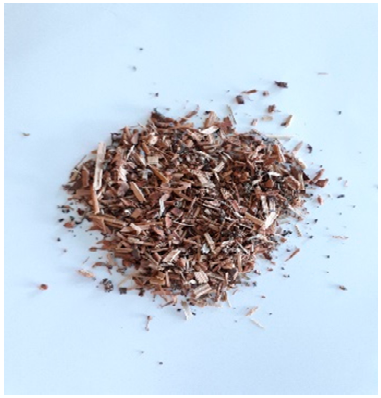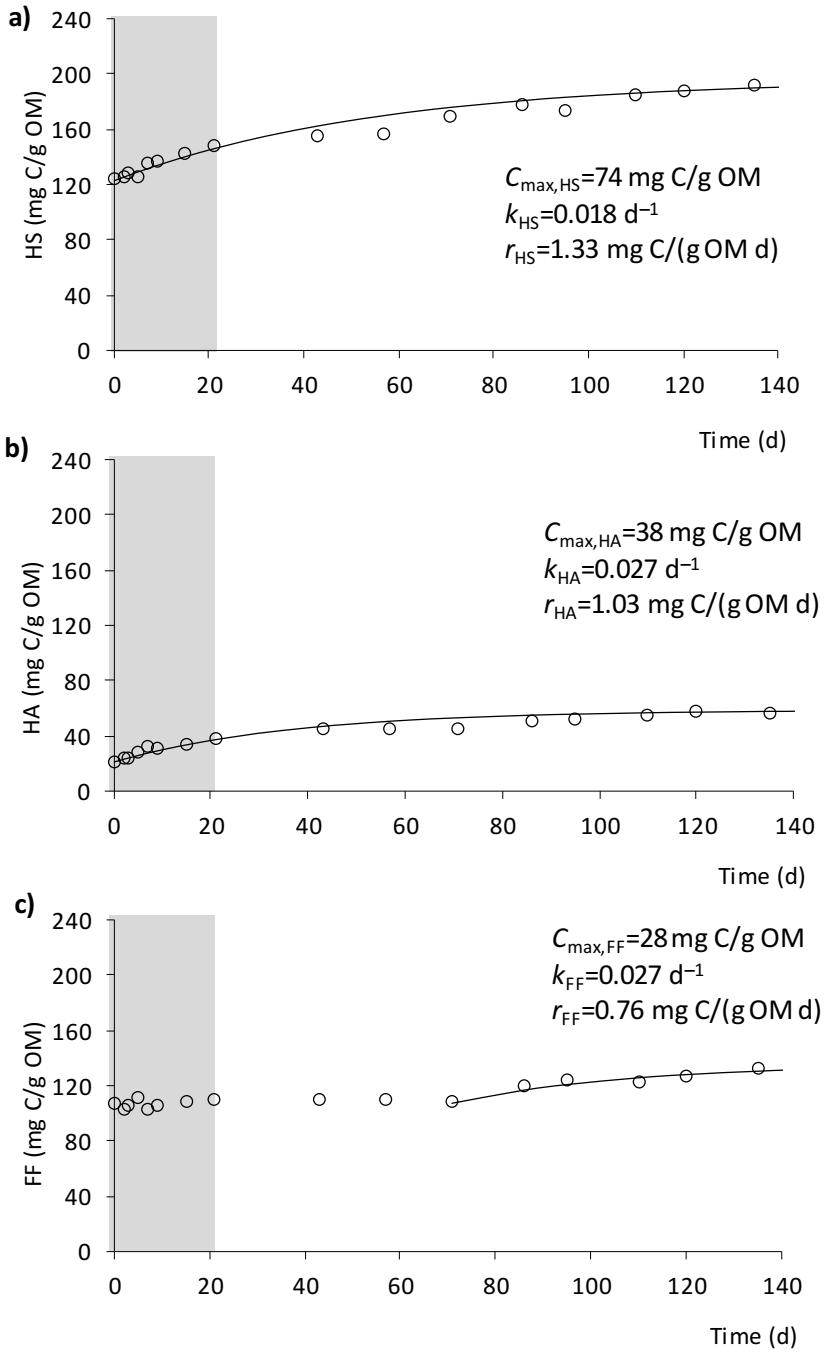Waste Willow-Bark from Salicylate Extraction Successfully Reused as an Amendment for Sewage Sludge Composting
Abstract
1. Introduction
2. Materials and Methods
2.1. Feedstock
2.2. Composting Mode
2.3. Analytical Methods
3. Results and Discussion
3.1. Temperature Profiles and Organic Matter Removal
3.2. OM Humification
4. Conclusions
Author Contributions
Funding
Institutional Review Board Statement
Informed Consent Statement
Data Availability Statement
Conflicts of Interest
Abbreviations
| C/N ratio | the ratio of the carbon (as TOC) content to nitrogen content in the mass of the sample |
| WWB | waste willow bark |
| OM | organic matter |
| DM | dry matter |
| kOM | rate constant of OM mineralization |
| HS | humic substances |
| HA | humic acids |
| FF | fulvic fraction |
| rHS | rate of HS formation |
| rHA | rate of HA formation |
| rFF | rate of FF formation |
| A | in Equation (1). it is the maximal loss in OM |
| t | composting time |
| rOM | the rate of the OM mineralization |
| C | in Equation (2). it is the concentration of HS, HA or FF over time |
| kHS | rate constant of HS formation |
| kHA | rate constant of HA formation |
| kFF | rate constant of FF formation |
| Cmax,HS | is the maximal increase in the concentration of HS |
| Cmax,HA | is the maximal increase in the concentration of HA |
| Cmax,FF | is the maximal increase in the concentration of FF |
| Ci | is the initial concentration of HS, HA or FF |
| DP | the degree of polymerization |
References
- Sánchez-Monedero, M.A.; Roig, A.; Cegarra, J.; Bernal, M.P. Relationships between water-soluble carbohydrate and phenol fractions and the humification indices of different organic wastes during composting. Bioresour. Technol. 1999, 70, 193–201. [Google Scholar] [CrossRef]
- Kulikowska, D.; Klimiuk, E. Organic matter transformations and kinetics during sewage sludge composting in a two-stage system. Bioresour. Technol. 2011, 102, 10951–10958. [Google Scholar] [CrossRef] [PubMed]
- Zhao, X.-L.; Li, B.-Q.; Ni, J.-P.; Xie, D.-T. Effect of four crop straws on transformation of organic matter during sewage sludge composting. J. Integr. Agric. 2016, 15, 232–240. [Google Scholar] [CrossRef]
- Kulikowska, D.; Sindrewicz, S. Effect of barley straw and coniferous bark on humification process during sewage sludge composting. Waste Manag. 2018, 79, 207–213. [Google Scholar] [CrossRef] [PubMed]
- Spanic, N.; Jambrekovic, V.; Medved, S.; Antonovic, A. Chemical and thermal properties of cellulose acetate prepared from white willow (Salix alba) and black alder (Alnus glutinosa) as a potential polymeric base of biocomposite materials. Chem. Biochem. Eng. Q. 2015, 29, 357–365. [Google Scholar] [CrossRef]
- Bodirlau, R.; Spiridon, I.; Teaca, C.A. Chemical investigation on wood tree species in a temperate forest, east-northern Romania. BioResources 2007, 2, 41–57. [Google Scholar] [CrossRef]
- Stolarski, M.J.; Szczukowski, S.; Tworkowski, J.; Wróblewska, H.; Krzyżaniak, M. Short rotation willow coppice biomass as an industrial and energy feedstock. Ind. Crops Prod. 2011, 33, 217–223. [Google Scholar] [CrossRef]
- Uçaroğlu, S.; Alkan, U. Composting of wastewater treatment sludge with different bulking agents. J. Air Waste Manag. 2016, 66, 288–295. [Google Scholar] [CrossRef]
- Bustamante, M.A.; Paredes, C.; Marhuenda-Egea, F.-C.; Pérez-Espinoza, A.; Bernal, M.P.; Moral, R. Co-composting of distillery with animal manures: Carbon and nitrogen transformations in the evaluation of compost stability. Chemosphere 2008, 72, 551–557. [Google Scholar] [CrossRef]
- Huang, G.F.; Wong, J.W.C.; Wu, Q.T.; Nagar, B.B. Effect of C/N on composting of pig manure with sawdust. Waste Manag. 2004, 24, 805–813. [Google Scholar] [CrossRef]
- García-Gómez, A.; Roig, A.; Bernal, L.P. Composting of the solid fraction of olive mill wastewater with olive leaves: Organic matter degradation and biological activity. Biores. Technol. 2003, 86, 59–64. [Google Scholar] [CrossRef]
- Alburquerque, J.A.; Gonzálvez, J.; Tartosa, G.; Baddi, G.A.; Cegarra, J. Evaluation of “alperujo” composting based on organic matter degradation, humification and compost quality. Biodegradation 2009, 20, 257–270. [Google Scholar] [CrossRef]
- Fersi, M.; Mbarki, K.; Gargouri, K.; Mechichi, T.; Hachicha, R. Assessment of organic matter biodegradation and physico-chemical parameters variation during co-composting of lignocellulosic wastes with Trametes trogii inoculation. Environ. Eng. Res. 2019, 24, 670–679. [Google Scholar] [CrossRef]
- Zhou, Y.; Selvam, A.; Wong, J.W. Evaluation of humic substances during co-composting of food waste, sawdust and Chinese medicinal herbal residues. Bioresour. Technol. 2014, 168, 229–234. [Google Scholar] [CrossRef]
- Veeken, A.; Nierop, K.; Wilde, V.; Hamelers, B. Characterization of NaOH extracted humic acids during composting of a biowaste. Bioresour. Technol. 2000, 72, 33–41. [Google Scholar] [CrossRef]
- Paredes, C.; Bernal, M.P.; Cegarra, J.; Roig, A. Biodegradation of olive mill wastewater sludge by its co-composting with agricultural wastes. Bioresour. Technol. 2002, 85, 1–8. [Google Scholar] [CrossRef]
- Domeizel, M.; Khalil, A.; Prudent, P. UV spectroscopy: A tool for monitoring humification and for proposing an index of the maturity of compost. Bioresour. Technol. 2004, 94, 177–184. [Google Scholar] [CrossRef]
- Jouraiphy, A.; Amir, S.; Gharous, M.; Revel, J.-C.; Hafidi, M. Chemical and spectroscopic analysis of organic matter transformation during composting of sewage sludge and green plant waste. Int. Biodeter. Biodegr. 2005, 56, 101–108. [Google Scholar] [CrossRef]
- Shin, H.S.; Lim, K.H. Spectroscopic and elemental investigation of microbial decomposition of aquatic fulvic acid in biological process of drinking water treatment. Biodegradation 1996, 7, 287–295. [Google Scholar] [CrossRef]
- Martin, J.P.; Haider, K. Microbial degradation and stabilization of 14C-labeled lignins, phenols, and phenolic polymers in relation to soil humus formation. In Lignin Biodegradation: Microbiology, Chemistry and Applications; Higuchi, T., Chang, H.M., Eds.; CRC Press: Boca Raton, FL, USA, 1980; Volume 1, pp. 77–100. [Google Scholar]
- Tuomela, M.; Vikman, M.; Hatakka, A.; Itävaara, M. Biodegradation of lignin in a compost environment: A review. Biores. Technol. 2000, 72, 169–183. [Google Scholar] [CrossRef]
- Dehorter, B.; Blondeau, R. Extracellular enzyme activities during humic acids degradation by the white rot fungi Phanerochate chrysosporium and Trametes versicolor. FEMS Microbiol. Lett. 1992, 94, 209–215. [Google Scholar] [CrossRef]
- Kästner, M.; Hofrichter, M. Biodegradation of humic substances. In Biopolymers, V.1-Lignin, Humic Substances and Coal; Steinbüchel, A., Hofrichter, M., Eds.; Wiley-VCH: Weinheim, Germany, 2001; pp. 349–378. [Google Scholar]
- Kontchou, C.Y.; Blondeau, R. Biodegradation of soil humic acids by Streptomyces viridosporus. Can. J. Microbiol. 1992, 38, 203–208. [Google Scholar] [CrossRef] [PubMed]
- Jindo, K.; Sonoki, T.; Matsumoto, K.; Canellas, L.; Roig, A.; Sanchez-Monedero, M. Influence of biochar addition on the humic substances of composting manures. Waste Manag. 2016, 49, 545–552. [Google Scholar] [CrossRef] [PubMed]
- Wang, C.; Tu, Q.; Dong, D.; Strong, P.J.; Wang, H.; Sun, B.; Wu, W. Spectroscopic evidence for biochar amendment promoting humic acid synthesis and intensifying humification during composting. J. Hazard. Mater. 2014, 280, 409–416. [Google Scholar] [CrossRef]





| Characteristics | Units | Components/Feedstock | |||
|---|---|---|---|---|---|
| Sewage Sludge | WWB | Wood Chips | Feedstock | ||
| Moisture | (%) | 85.2 ± 1.7 | 16.1 ± 0.3 | 26.1 ± 0.7 | 67 ± 1.8 |
| OM | (% DM) | 89.2 ± 1.4 | 93.2 ± 3.1 | 97.1 ± 1.9 | 90.2 ± 1.4 |
| TN | (% DM) | 5.64 ± 0.3 | 1.83 ± 0.04 | 0.98 ± 0.02 | 3.2 ± 0.04 |
| TOC | (% DM) | 42.1 ± 1.3 | 54.1 ± 1.7 | 52.3 ± 1.9 | 46.7 ± 0.9 |
| OM/N | – | 15.8 | 50.9 | – | 28.2 |
| C/N | – | 7.46 | 29.6 | – | 14.6 |
Publisher’s Note: MDPI stays neutral with regard to jurisdictional claims in published maps and institutional affiliations. |
© 2021 by the authors. Licensee MDPI, Basel, Switzerland. This article is an open access article distributed under the terms and conditions of the Creative Commons Attribution (CC BY) license (https://creativecommons.org/licenses/by/4.0/).
Share and Cite
Kulikowska, D.; Bernat, K. Waste Willow-Bark from Salicylate Extraction Successfully Reused as an Amendment for Sewage Sludge Composting. Sustainability 2021, 13, 6771. https://doi.org/10.3390/su13126771
Kulikowska D, Bernat K. Waste Willow-Bark from Salicylate Extraction Successfully Reused as an Amendment for Sewage Sludge Composting. Sustainability. 2021; 13(12):6771. https://doi.org/10.3390/su13126771
Chicago/Turabian StyleKulikowska, Dorota, and Katarzyna Bernat. 2021. "Waste Willow-Bark from Salicylate Extraction Successfully Reused as an Amendment for Sewage Sludge Composting" Sustainability 13, no. 12: 6771. https://doi.org/10.3390/su13126771
APA StyleKulikowska, D., & Bernat, K. (2021). Waste Willow-Bark from Salicylate Extraction Successfully Reused as an Amendment for Sewage Sludge Composting. Sustainability, 13(12), 6771. https://doi.org/10.3390/su13126771






